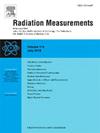Radiation damage of the W2 plastic scintillator under ultra-high dose rate FLASH electron beam
IF 2.2
3区 物理与天体物理
Q2 NUCLEAR SCIENCE & TECHNOLOGY
引用次数: 0
Abstract
Objectives
This project aimed to detail the response of the Standard Imaging Exradin-W2 plastic scintillator detector (PSD) as a function of accumulated dose under ultra-high dose rate (UHDR) electron beams.
Approach
This experiment was performed with 9 PSDs and 3 clear optical guide fibers to distinguish between the radiation damage response of the optical guide and the response of the scintillator. The PSDs and the transmitting optical fibers were exposed to a 9 MeV electron beam using a Mobetron electron linear accelerator (IntraOp) at a dose per pulse (DPP) of 3 and 8 Gy, reaching a total cumulative dose of 12 kGy. The PSD's response to both conventional dose rate (CDR) and UHDR irradiation was measured in triplicate prior to any radiation exposure. Conventional and UHDR irradiations were repeated at various increasing doses to assess changes in the sensitivity of the detector. The high dose irradiations were always performed under UHDR. After 2 months with no radiation exposure, the detectors and fibers underwent irradiation regimens identical to the initial ones to quantify their recovery.
Main results
The Exradin-W2 PSD blue channel exhibited an average sensitivity loss of (2.0 ± 0.2) %/kGy under UHDR and similar loss was found for CDR. The optical fiber showed a mean response decrease of (1.2 ± 0.1) %/kGy for UHDR. When irradiating the optical fiber of three W2s, the average sensitivity loss in the blue signal was (6.4 ± 0.2) %/kGy for CDR and (6.3 ± 0.2) %/kGy for UHDR. Mean response recovery of 10 ± 3 % was observed for detectors exposed to conventional beams and (18 ± 4) % for UHDR for the blue channel. Overall, the W2 PSD's response (blue and green channels) remained within 3 % of the initial baseline measurement when the cumulative dose was under 2 kGy.
Significance
Our results indicate that the W2 PSD exhibited greater sensitivity loss under UHDR than conventional beams found in prior studies. The results suggest that varying DPP does not change the sensitivity loss of the W2. We noted a decrease of the blue channel relative to the green channel in the optical fiber response, which adds to the overall radiation damage to the PSD. Therefore, users should track cumulative dose and recalibrate after each 2 kGy of exposure.
超高剂量率FLASH电子束下W2塑料闪烁体的辐射损伤
目的研究标准成像Exradin-W2型塑料闪烁体探测器(PSD)在超高剂量率(UHDR)电子束下累积剂量的变化规律。方法采用9根psd和3根透明光纤进行实验,以区分光波导的辐射损伤响应和闪烁体的响应。利用Mobetron电子直线加速器(IntraOp)将psd和传输光纤分别暴露在3和8 Gy /脉冲剂量的9 MeV电子束下,总累积剂量达到12 kGy。在任何辐射暴露之前,对PSD对常规剂量率(CDR)和UHDR辐照的反应进行了三次测量。以不同的增加剂量重复常规和UHDR辐照,以评估探测器灵敏度的变化。高剂量辐照总是在UHDR下进行。2个月无辐射照射后,探测器和纤维接受与最初相同的照射方案,以量化其恢复。Exradin-W2 PSD蓝色通道在UHDR下的平均灵敏度损失为(2.0±0.2)%/kGy,在CDR下也有类似的损失。光纤对UHDR的平均响应降低了(1.2±0.1)%/kGy。当辐照三个W2s光纤时,蓝色信号的平均灵敏度损失为CDR(6.4±0.2)%/kGy, UHDR(6.3±0.2)%/kGy。对于暴露在常规光束下的探测器,平均响应回收率为10±3%,对于蓝色通道的UHDR,平均响应回收率为(18±4)%。总的来说,当累积剂量低于2kgy时,W2 PSD的反应(蓝色和绿色通道)保持在初始基线测量的3%以内。我们的研究结果表明,W2 PSD在UHDR下表现出比以往研究中发现的常规光束更大的灵敏度损失。结果表明,不同的DPP不会改变W2的灵敏度损失。我们注意到光纤响应中蓝色通道相对于绿色通道的减少,这增加了对PSD的总体辐射损伤。因此,使用者应追踪累积剂量,并在每2 kGy的照射后重新校准。
本文章由计算机程序翻译,如有差异,请以英文原文为准。
求助全文
约1分钟内获得全文
求助全文
来源期刊

Radiation Measurements
工程技术-核科学技术
CiteScore
4.10
自引率
20.00%
发文量
116
审稿时长
48 days
期刊介绍:
The journal seeks to publish papers that present advances in the following areas: spontaneous and stimulated luminescence (including scintillating materials, thermoluminescence, and optically stimulated luminescence); electron spin resonance of natural and synthetic materials; the physics, design and performance of radiation measurements (including computational modelling such as electronic transport simulations); the novel basic aspects of radiation measurement in medical physics. Studies of energy-transfer phenomena, track physics and microdosimetry are also of interest to the journal.
Applications relevant to the journal, particularly where they present novel detection techniques, novel analytical approaches or novel materials, include: personal dosimetry (including dosimetric quantities, active/electronic and passive monitoring techniques for photon, neutron and charged-particle exposures); environmental dosimetry (including methodological advances and predictive models related to radon, but generally excluding local survey results of radon where the main aim is to establish the radiation risk to populations); cosmic and high-energy radiation measurements (including dosimetry, space radiation effects, and single event upsets); dosimetry-based archaeological and Quaternary dating; dosimetry-based approaches to thermochronometry; accident and retrospective dosimetry (including activation detectors), and dosimetry and measurements related to medical applications.
 求助内容:
求助内容: 应助结果提醒方式:
应助结果提醒方式:


